From "Man on the Ocean: A Book about Boats and Ships"

Like all other vessels, sloops vary in size, but none of them attain to great magnitude. As a class, they are the smallest decked vessels we have. From 40 to 100 tons burden is a very common size. A sloop of 40 tons burden is what we ordinarily call a little ship, and one of 100 tons is by no means a big one. The hull of such a vessel being intended exclusively to carry cargo, very little space is allowed for the crew.
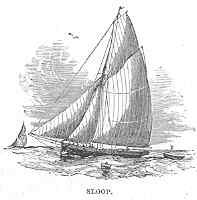
The cabins of the smaller-sized sloops are seldom high enough to permit of an ordinary man standing erect. They are usually capable of affording accommodation to two in the cabin, and three or four in the forecastle,—and such accommodation is by no means ample. The class to which vessels belong is determined chiefly by the number of their masts and by the arrangement and the form of their sails.
The distinctive peculiarity of the sloop is, that it has but one mast; and its rig is, nautically speaking, fore-and-aft—that is to say, the sails are spread with their surfaces parallel to the sides of the vessel, not stretched upon yards across the vessel. The term “fore-and-aft” is derived from the forward part and the after part of the ship. Fore-and-aft sails, then, are such as are spread upon yards which point fore and aft, not across the ship. We conceive this elaborate explanation to be necessary for some readers, and, therefore, don’t apologise for making it. A ship whose sails are spread across the hull is said to be square-rigged. Sometimes, however, a sloop carries one and even two square sails.
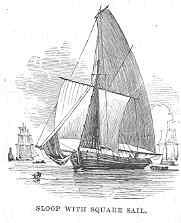
The masts, yards, and sails of a sloop are as follows:— As has been already said, one of the distinctive peculiarities of a sloop is, that it has only one mast. This mast is sometimes formed of one stick, sometimes of two; the second, or top-mast, being fastened to the top of the lower mast by cross-trees and cap, in such a way that it may be hoisted or lowered at pleasure. A sloop has usually four sails,—a main-sail, fore-sail, gaff, and jib. The main-sail is behind the lower mast. It reaches from within a few feet of the deck to the top of the lower mast, and spreads out upon two yards towards the stern or after part of the ship, over which it projects a few feet. The lower yard of the main-sail is called the boom, and the upper the main-sail yard. This is by far the largest sail in the sloop. Above it is spread the gaff, which is comparatively a small sail, and is used when the wind is not very strong. The fore-sail is a triangular sheet, which traverses on the fore-stay; that is, the strong rope which runs from the lower mast-head to the bow, or front part of the sloop. On the bowsprit is stretched the jib, another triangular sail, which reaches nearly to the top of the lower mast. The only sail that rises above the lower mast is the gaff. In stormy weather this sail is always taken down. If the wind increases to a gale, the jib is lowered and lashed to the bowsprit.
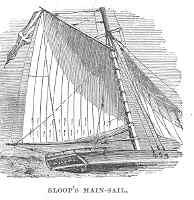
Should the gale increase, a reef is taken in the main-sail. One, two, three, and sometimes four reefs are taken in, according to the violence of the storm; when the last reef is taken in, the sloop is under close-reefed main-sail. Increased violence in the storm necessitates the taking in of the main-sail and lying-to under the fore-sail, or a part of it. Lying-to is putting the sloop’s head to the wind, and placing the helm in such a position that it tends to turn the vessel in one direction, while the gale acting on the fore-sail tends to force it in another, and thus it remains stationary between the two opposing forces. Many vessels thus lie-to, and ride out the severest storm. Sometimes, however, a dreadful hurricane arises, and compels vessels to take in all sails and “scud under bare poles”—that is, drive before the wind without any sails at all; and it is at such seasons that man is forced to feel his utter helplessness, and his absolute dependence on the Almighty. Of course, there are slight variations in the rig of sloops—some have a square-sail, and some have a flying-jib; but these are not distinctive sails, and they are seldom used in small craft.
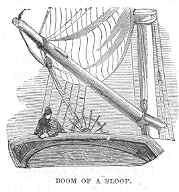
Doubtless, those of our readers who have dwelt on the sea-coast must have observed that boats and vessels frequently sail in precisely opposite directions, although acted upon by the same wind. This apparent paradox may be explained thus:—
Suppose a vessel with the bow and stern sharp and precisely alike, so that it might sail backwards or forwards with equal facility. Suppose, also, that it has two masts exactly the same in all respects—one near the bow, the other near the stern. Suppose, further, a square sail stretched between the two masts quite flat; and remember that this would be a fore-and-aft sail—namely, one extending along the length, not across the breadth of the vessel.
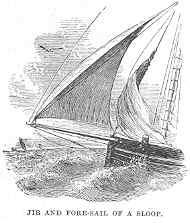
Well, now, were a breeze to blow straight against the side of such a vessel, it would either blow it over, flat on its side, or urge it slowly sideways over the water, after the fashion of a crab. Now remove one of these masts—say the stern one—and erect it close to the lee-side of the vessel (that is, away from the windward-side), still keeping the sail extended. The immediate effect would be that the sail would no longer present itself flatly against the wind, but diagonally. The wind, therefore, after dashing against it would slide violently off in the direction of the mast that had been removed, that is, towards the stern. In doing so it would, of course, give the vessel a shove in the opposite direction; on the very same principle that a boy, when he jumps violently off a chair, not only sends his body in one direction, but sends the chair in the opposite direction. So, when the wind jumps off the sail towards the stern, it sends the ship in the opposite direction—namely, forward. Reverse this; bring back the mast you removed to its old place in the centre of the deck, and shift the front mast near to the lee-bulwarks. The wind will now slide off the sail towards the bow, and force our vessel in the opposite direction—namely, backward; so that, with the same side wind, two ships may sail in exactly opposite directions.
By means of the rudder, and placing the sails in various positions, so as to cause them to press against the masts in a particular manner, vessels can be made to sail not only with a side wind, but with a breeze blowing a good deal against them—in nautical phraseology, they can be made to sail “close to the wind.” In short, they can sail in every direction, except directly in the “teeth” of the wind. Some ships sail closer to the wind than others; their powers in this respect depending very much on the cut of their sails and the form of their hulls.






|